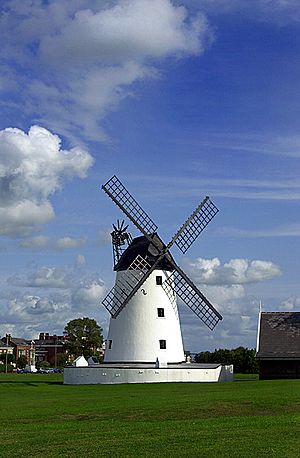Lytham Windmill facts for kids
Lytham Windmill stands proudly on Lytham Green in the seaside town of Lytham St Annes, Lancashire, England. It's a type of windmill called a tower mill, and it was built to grind wheat and oats into flour. The mill stopped making flour in 1921. Since then, it has been owned by the town and looked after by Fylde Borough Council. They open it for visitors during the summer months. The windmill also has a museum run by the Lytham Heritage Trust, where you can learn all about how flour was made and the mill's interesting past.
The Story of Lytham Windmill
Windmills have been a part of Lytham's history for a very long time. Lytham Windmill was built around 1805. A miller named Richard Cookson got permission from the local landowner, known as the Squire, to build his "windy milne" on the Lytham marshes.
Early Days and Changes
Some parts of the mill's machinery, like a very old main shaft made of strong Baltic oak, were actually saved from other local mills. Later, a stone base was added around the bottom of the mill to make it safer. There used to be a smoky drying kiln next to the mill, but it was moved away to Kiln Street. This happened because people living in the fancy new houses nearby didn't like the smoke. Over time, the land around the mill was flattened and covered with grass, creating the lovely green area you see today between the houses and the sea.
The Fire and Restoration
On January 2, 1919, a very strong storm hit Lytham. The wind was so powerful that it made the windmill's sails spin out of control, even with the brakes on! Sparks flew, and the wooden parts of the mill caught fire. The windmill was quickly destroyed inside. It remained an empty shell until 1921. That year, the Squire, John T. Clifton, gave the burnt-out building to the Lytham Urban District Council.
After the fire, the windmill was restored. It got a new top (called a cap) and a set of fake sails. For many years, it was used for different things. It was a cafe, a meeting place for local boating clubs, and even an electricity sub-station.
In 1951, Lytham Windmill was officially recognized as a Grade II listed building. This means it's an important historic building that needs to be protected. Then, in 1989, Fylde Borough Council completely restored the windmill. It was then opened to the public, allowing everyone to explore its history. Today, Lytham Windmill is managed by Fylde Borough Council and the Lytham Heritage Group, working together to keep its story alive.
See also
- Listed buildings in Lytham
- List of windmills in Lancashire


